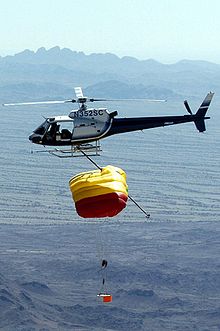Mid-air retrieval

Mid-air retrieval is a technique used in atmospheric reentry when the reentering vehicle is incapable of a satisfactory unassisted landing. The vehicle is slowed by means of parachutes, and then a specially-equipped aircraft matches the vehicle's trajectory and catches it in mid-air.
This is a risky technique, and so is only used when other forms of landing are infeasible. Successful mid-air retrieval requires correct operation of the retrieving aircraft, favourable atmospheric conditions, and successful execution of a tricky manoeuvre, in addition to correct operation of the vehicle itself. Complicating matters, helicopters, which are the optimal aircraft for these operations due to their manoeuverability, are particularly prone to mechanical breakdown. These risks can be mitigated somewhat: for example, multiple recovery aircraft can be used. The need for human aviators to perform a manoeuvre which would normally be classed as a stunt may in the future be avoided by advances in unmanned aerial vehicles.
Notable uses of the technique:
- The early-1960s era Corona reconnaissance satellite returned delicate film capsules to Earth that required mid-air retrieval by a JC-130 Hercules & HC-130 airlifter. These aircraft were manned by a crew of 10 personel. Two pilots, one flight engineer Two telemetry operators, one winch operator and four riggers. The telemetry operators would aquire the location of the satellite and relay the info to the pilots. Once visually aquired the pilots would head on course to the satellite decending towards the pacific ocean. One could visually aquire the satellite and its parachute at an altitude of approximately 50,000 ft. The winch operator and the riggers would deploy the retrieving apparatus called the "Loop", which consisted of high quality nylon rope with a series of brass hooks spliced into the apparatus. The whole snatching operation by the pilots was done visually. The winch operator and the four riggers would deploy the loop. As the aircraft flew over the parachute you would feel a little uplifting of the aircraft. Once contact was made between the parachute and the loop the winch line would pay out and stop. The winch then was put into gear and the retrevial process commenced. Once onboard the aircraft flew back to Hickam Air Force Base, where they were stationed and offload the satellite or the canister onto a truck and then loaded immediately onto a running C-141 airlifter and then transpoted to a location, in Maryland, for analysis. The crews aquired these skills by practicing almost daily on practice missions, carried out with other aircraft dropping dummy bombs with chutes attached. The weights were 200 lbs. in the early 70's and later to the conical parachute system which weighed in at 1,100lbs. To say the least, there were some very interesting activities that happened during practice.
- The Genesis mission returned a sample of solar wind that was so delicate that it would have been damaged by a parachute landing, so a mid-air retrieval using helicopters flown by Hollywood stunt pilots contracted by NASA was planned. Its parachutes failed to deploy, so mid-air retrieval was impossible and the capsule crashed.
- An early design for SpaceShipOne called for a shuttlecock-like shape that would have made it incapable of landing independently, necessitating mid-air retrieval. This was deemed too risky, and the final design made the spacecraft capable of independent horizontal landing while cleverly retaining the desired aerodynamic qualities for the early part of reentry.
